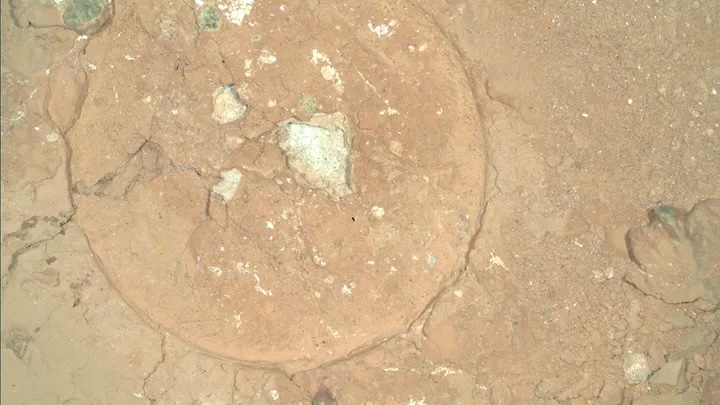Strange green spots on Mars found by NASA's Perseverance rover
NASA's Perseverance rover found strange green spots in Martian rock, potentially indicating a past interaction with liquid water.

NASA's Perseverance rover is approaching four years of activity on the Martian surface — and all this time, the rover has been exploring ancient environments, collecting samples, and investigating whether our reddish neighbor may have once supported microbial life
In its latest findings, Perseverance took a nighttime mosaic image of the Malgosa Crest abrasion patch, at a location called the "Serpentine Rapids," using its SHERLOC WATSON camera. The image revealed white, black and, surprisingly, green-ish spots within the rock. While these rocks' composition remains a mystery, the unexpected find has scientists excited about what other hidden gems Perseverance might stumble across going forward.
To acquire images from within the rock, Perseverance made an abrasion patch in a rock outcrop named "Wallace Butte." The abrasion patch measured five centimeters (roughly two inches) in diameter, and the large green spot that can be seen in the upper left of the image is approximately two millimeters (about 0.08 inches) in diameter. The image was acquired on Aug. 19, on Martian day 1,243 of the Mars 2020 mission.
Rocks on Earth that resemble the studied red Martian rocks typically get their color from oxidized iron, the same type of iron that makes our blood red and similar to the oxidized red rust you might find on your car. The green spots that can be seen in Perseverance's new image are also common in red rocks on Earth, and are formed when liquid water seeps through sediment before hardening into rock. This process supports a chemical reaction that transforms oxidized iron to its reduced form, creating a green hue in the rock.
Related: 32 things on Mars that look like they shouldn't be there
Sometimes, microbes play a role in this process on Earth, but decaying organic matter can also create the right conditions for the reduction reaction. Chemical interaction between sulfur and iron can also facilitate iron-reduction reactions without the help of microorganisms.
Exactly what type of reaction was responsible for the green spots found in Perseverance's image will remain a puzzle, however, as there was not enough room for the rover to safely place its arms holding the SHERLOC and PIXL instruments directly on top of the green spot. Thus, the robotic explorer was denied a closer look. The team hopes Perseverance unearths something similar in the future to get a better understanding of what type of chemical reactions are generating these features in the rock.
Sign up for the Live Science daily newsletter now
Get the world’s most fascinating discoveries delivered straight to your inbox.
Next on the agenda for Perseverance is to ascend to the Jezero Crater rim, during which time it will have to cover steep terrain. Then it will finally leave the crater it has called home for the last two years.
Originally posted on Space.com.
Conor Feehly is a New Zealand-based science writer. He has earned a master's in science communication from the University of Otago, Dunedin. His writing has appeared in Cosmos Magazine, Discover Magazine and ScienceAlert. His writing largely covers topics relating to neuroscience and psychology, although he also enjoys writing about a number of scientific subjects ranging from astrophysics to archaeology.












